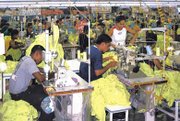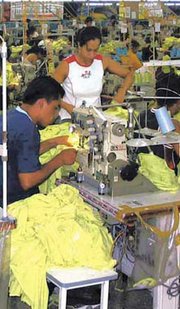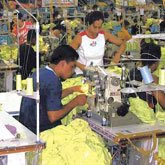DR-CAFTA Loophole Closure Helps Regional Sewing-Thread Producers
More than five years after a free-trade agreement was negotiated between the United States and a handful of Central American countries, a glaring hole in the accord has been fixed.
Under the Dominican Republic–Central American Free Trade Agreement, all sewing thread used in apparel production had to come from the region to qualify for duty-free status, so that thread had to be manufactured in the United States or in the other six countries that make up DR-CAFTA.
However, sewing thread made from single multifilament yarns could come from outside the region, which resulted in Central American factories purchasing those kinds of sewing thread from China or other countries and still getting duty-free status on their goods.
That loophole finally was closed during a ministerial meeting of DR-CAFTA leaders held Feb. 22–23 in San Salvador, El Salvador, meaning that U.S. and Central American sewing-thread producers could see a boost in their business. After the ministerial approval, each country’s legislature must approve the change before it goes into effect. At the earliest, that would be this summer, but most trade experts don’t expect a final change until the end of the year.
T-shirt and underwear makers, who make up the bulk of apparel manufacturing in Central America, are the biggest users of this sewing thread.
Auggie Tantillo, a spokesperson for the American Manufacturing Trade Action Coalition, said the sewing-thread fix “is a job-creating, win-win for U.S. sewing-thread producers and their DR-CAFTA counterparts.”
Under the free-trade agreement, Central America accounts for a little more than 10 percent of apparel imported into the United States ($7 billion) in 2010, up 14 percent from 2009.
“A significant amount of thread that had been sourced in the United States switched over to Asia,” said Cass Johnson, president of the National Council of Textile Organizations in Washington, D.C. “That will come back and help increase the production of sewing thread in the region.”
One company poised to benefit is Unifi Inc., a diversified producer and processor of polyester and nylon yarns and of sewing thread. It is also a big supplier to sewing-thread companies such as Coats and American & Efird.
“Over 90 percent of what we do [in thread] is single thread. We have had a lot of import competition because of the cost competitiveness,” said Jane Johnson, the government affairs officer for Unifi in Greensboro, N.C.
Unifi recently opened a facility in El Salvador with a texturing and twisting operation. At full capacity, it is expected to employ 175 workers and supply sewing thread, which is a big market in Central America. “We are very invested in the region, and it is one of the biggest export regions for us. For that reason, this correction is very important,” Johnson said.
American & Efird, which produces sewing thread in Costa Rica and has 230 employees in the Central American region, will also reap some financial benefits from this. “We produce it down there now,” said Knox Winget, vice president of marketing for American & Efird. “It will just be an extension of business that already exists.”
The exclusion of regional requirements for sewing thread made from single multifilament yarns in the DR-CAFTA agreement was a glitch because of a flawed, technical definition of sewing thread under the harmonized tariff schedule. Thread producers have been trying to get this glitch fixed since DR-CAFTA first went into effect in 2006 under the Bush administration.
The new rule poses a hazard to Central American apparel producers that might be unaware of the changes. Continuing to use sewing thread from outside the region would automatically disqualify apparel for duty-free status, resulting in tariffs that can reach as high as 32 percent of a garment’s value.
Customs officials have labs to test the origin of fabric and thread.
Manufacturers that carry high inventories of thread made of single multifilament yarns could also be stuck with stock they can’t use. “Companies need to keep track of their assortments and watch the news about when this becomes effective so they can change over,” said Jon Fee, a customs and trade attorney with Alston & Bird in Washington, D.C. “What will hurt you is getting stuck with extra thread you can’t use.”
Other DR-CAFTA regulations considered at the ministerial meeting in El Salvador included increasing by 25 percent the amount of Mexican denim that Central American apparel producers can use in Central America and still qualify for duty-free exports to the United States. When Mexican cumulation went into effect in 2008, Central American factories could use up to 100 million square meters equivalent of denim on a first-come, first-served basis. Recent statistics show that only 1.1 percent of Central American garments coming into the United States used fabric under the Mexican cumulation program.
Another change to the DR-CAFTA rule is that short-supply fabric, which is not made in the region, does not have to use regional elastomers, such as spandex, to qualify for duty-free status.
Two-way trade between the United States and its Central American free-trade partners grew from $35 billion in 2005 to $48 billlion in 2010.
























